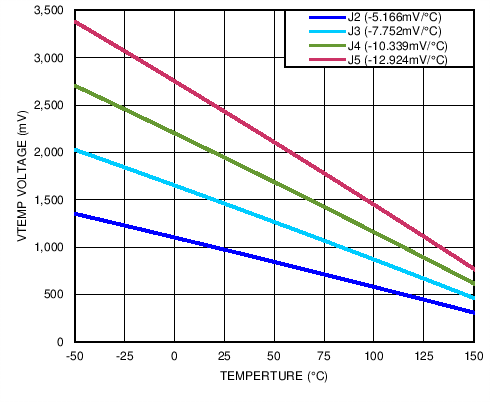SNIS152E May 2009 – July 2015 LM57
PRODUCTION DATA.
- 1 Features
- 2 Applications
- 3 Description
- 4 Revision History
- 5 Device Comparison Table
- 6 Pin Configuration and Functions
-
7 Specifications
- 7.1 Absolute Maximum Ratings
- 7.2 ESD Ratings
- 7.3 Recommended Operating Conditions
- 7.4 Thermal Information
- 7.5 Electrical Characteristics - Accuracy Characteristics - Trip Point Accuracy
- 7.6 Electrical Characteristics - Accuracy Characteristics - VTEMP Analog Temperature Sensor Output Accuracy
- 7.7 Electrical Characteristics
- 7.8 Switching Characteristics
- 7.9 Typical Characteristics
-
8 Detailed Description
- 8.1 Overview
- 8.2 Functional Block Diagram
- 8.3 Feature Description
- 8.4 Device Functional Modes
- 9 Application and Implementation
- 10Power Supply Recommendations
- 11Layout
- 12Device and Documentation Support
- 13Mechanical, Packaging, and Orderable Information
パッケージ・オプション
メカニカル・データ(パッケージ|ピン)
サーマルパッド・メカニカル・データ
発注情報
1 Features
- See LM57-Q1 Data Sheet for AEC-Q100 Grade 1/Grade 0/Grade 0 Extended (Qualified and Manufactured on an Automotive Grade Flow)
- Trip Temperature Set by External Resistors with
Accuracy of ±1.7°C or ±2.3°C from −40°C to +150°C - Resistor Tolerance Contributes Zero Error
- Push-Pull and Open-Drain Switch Outputs
- Wide Operating Temperature Range of −50°C to 150°C
- Very Linear Analog VTEMP Temp Sensor Output
with ±0.8°C or ±1.3°C Accuracy from −50°C to +150°C - Short-Circuit Protected Analog and Digital Outputs
- Latching Function for Digital Outputs
- TRIP-TEST Pin Allows In-System Testing
- Low Power Minimizes Self-Heating to Under 0.02°C
2 Applications
- Factory Automation
- Industrial
- Automotive
- Down Hole
- Avionics
- Telecom Infrastructure
3 Description
The LM57 device is a precision, dual-output, temperature switch with analog temperature sensor output for wide temperature industrial applications. The trip temperature (TTRIP) is selected from 256 possible values in the range of –40°C to 150°C. The VTEMP is a class AB analog voltage output that is proportional to temperature with a programmable negative temperature coefficient (NTC). Two external 1% resistors set the TTRIP and VTEMP slope. The digital and analog outputs enable protection and monitoring of system thermal events.
Built-in thermal hysteresis (THYST) prevents the digital outputs from oscillating. The TOVER and TOVER digital outputs will assert when the die temperature exceeds TTRIP and will de-assert when the temperature falls below a temperature equal to TTRIP minus THYST.
TOVER is active-high with a push-pull structure. TOVER is active-low with an open-drain structure. Tying TOVER to TRIP-TEST will latch the output after it trips. The output can be cleared by forcing TRIP-TEST low. Driving the TRIP-TEST high will assert the digital outputs. A processor can check the state of TOVER or TOVER, confirming they changed to an active state. This allows for in situ verification that the comparator and output circuitry are functional after system assembly. When TRIP-TEST is high, the trip-level reference voltage appears at the VTEMP pin. The system could then use this voltage to calculate the threshold of the LM57.
Device Information (1)(2)
| PART NUMBER | PACKAGE | BODY SIZE (NOM) |
|---|---|---|
| LM57BISD | WSON (8) | 2.50 mm × 2.50 mm |
| LM57FPW | TSSOP (8) | 3.00 mm × 6.40 mm |
- For all available packages, see the orderable addendum at the end of the data sheet.
- For device comparison see Device Comparison Table.
LM57 Overtemperature Alarm

Temperature Transfer Function
